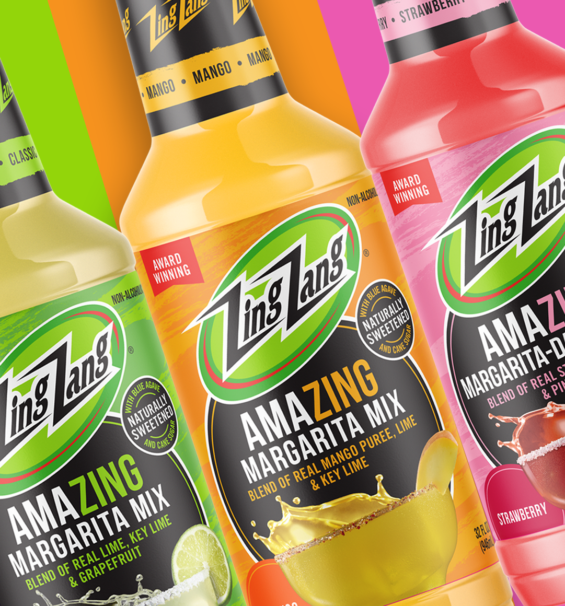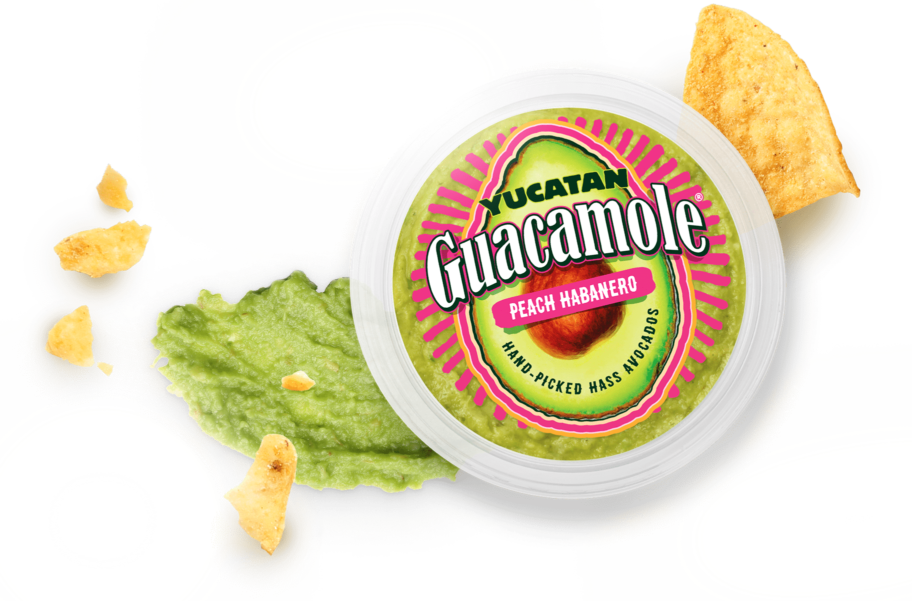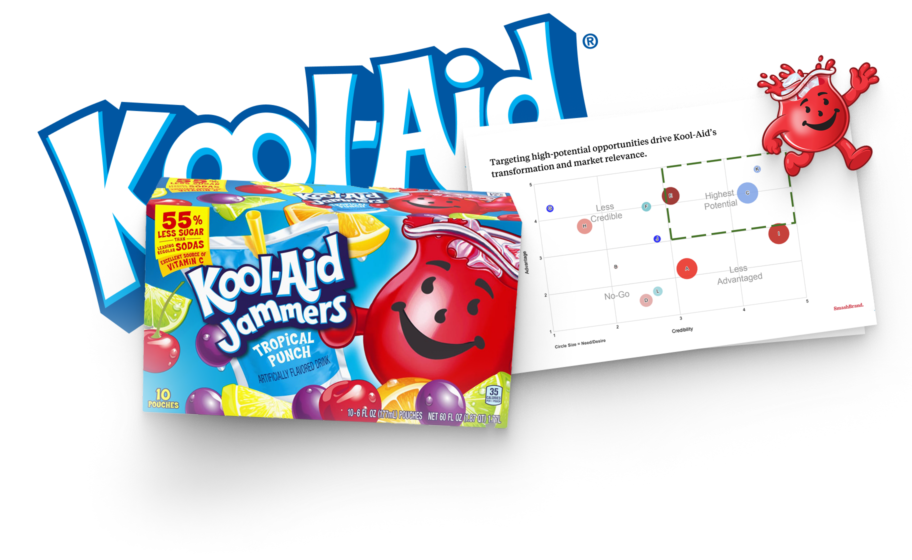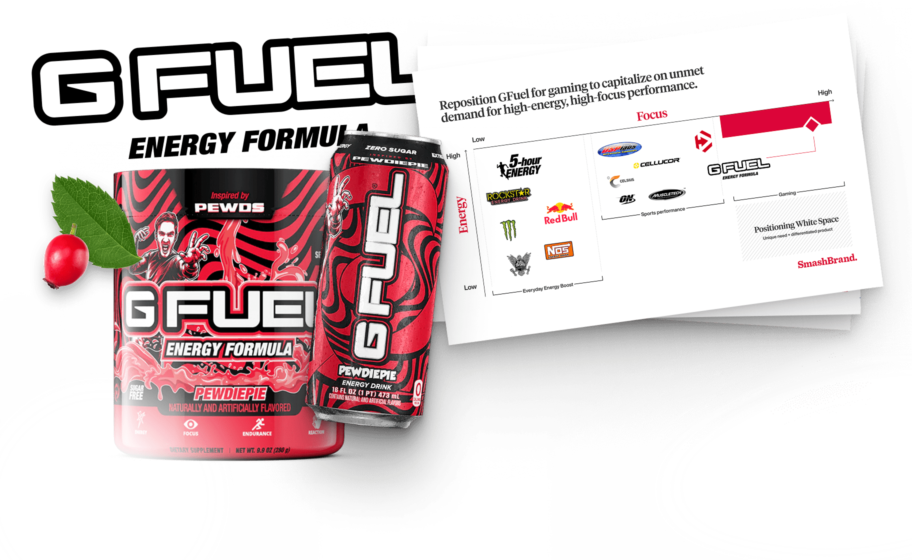The FMCG industry is highly competitive. In the fast-moving consumer goods sector, you compete against heavily advertised big-name brands, viral influencer-led newcomers, and category innovators offering new features and formulations. With such fierce competition, fast-moving consumer goods brands must have packaging designs that nurture brand differentiation while encouraging consumer engagement to solidify purchase decisions. Creating a proven FMCG packaging design to showcase your product is the only way to take heavy competition head-on.
This article explores the resources required to develop optimized packaging designs that effectively stand out on the retail shelf. You will learn how to create a packaging design that achieves sufficient brand recall to elicit a habitual response from consumers.
Here is what you will learn in this article.
- The data-driven importance of packaging design in the FMCG industry.
- How Packaging Design Can Spark Consumer Engagement.
- What research needs to be conducted before a packaging design to understand the consumer?
- The fundamental elements of an FMCG packaging design.
- The role of testing in the packaging design process.
- When to engage with a packaging design agency.
- How to guarantee a performance increase with your packaging design.
Packaging design in the most challenging FMCG categories is a complex process requiring a deep understanding. This guide will give you a foundation upon which to build. From understanding consumer behavior to each design element, you will gain insights to enhance your FMCG branding, sales, and marketing. If you are an FMCG decision-maker, this guide will equip you with the knowledge necessary to win on retail shelves.
The importance of packaging design in the FMCG industry
The statistical importance of packaging design for FMCG products cannot be overstated. A report by Wharton University states that 70% of purchasing decisions are made at the point of sale. While you can use in-store FMCG advertising, such as shelf talkers, to influence purchase consideration, the packaging design plays the most pivotal role in capturing consumers’ attention. Ultimately, it’s the viewable product itself that has the most significant influence on their purchasing decision.
Packaging design is crucial in capturing consumers’ attention and influencing their purchase decisions. Even if you remove the design and messaging, packaging still plays a role. Ipsos found that packaging alone influences 72% of consumers’ purchase decisions.
And if you think the competition isn’t paying attention to this, consider this. Depending on the geographic region and demographic audience, somewhere between 50% and 64% are willing to try a new product based on what they see in the store.
One of the surveys, conducted by Nielsen, also found that packaging design is the most critical element in purchasing for 41% of consumers. These statistics highlight the importance of a packaging design for “each” time the consumer considers your product.
Understanding how your packaging competes against an ever-evolving landscape is critical to your brand strategy.
How The Packaging Design Drives Consumer Engagement
In the FMCG industry, packaging is your brand’s frontline communicator. A successful consumer goods packaging design connects instantly with potential customers by communicating a brand’s identity, values, and promise in seconds. Fast-moving consumer goods companies must create distinctive packaging that drives brand recognition and sticks in the consumer’s subconscious long after the purchase.
Consumers don’t build loyalty by seeing “another box” on the shelf. They remember the brand that looked different, felt authentic, and told a story they wanted to be part of. This is where clever branding for FMCG, from bold colors and eco-friendly packaging choices to a refined visual identity, elevates brand awareness and increases repeat sales.
Attracting consumer attention is crucial, but actual engagement goes beyond that. It’s not enough to visually dominate the aisle. Packaging must spark curiosity, create emotional resonance, and inspire confidence, transforming a glance into a sale. Strategic consumer packaging branding ensures your product wins both the moment of attention and the moment of decision.
In the FMCG packaging market, brands that invest in intelligent packaging material choices, such as sustainable packaging, recycled materials, and innovative packaging solutions, gain even more relevance with today’s values-driven shoppers.
Understanding the Consumer
Competing with national retailers demands deeper insights, rooted not just in trade show chatter, customer service anecdotes, or retailer feedback. Real success in consumer packaging branding and fast-moving consumer goods packaging markets comes from knowing precisely what drives consumer attention and decision-making at the shelf. Without this foundation, building lasting brand value and true differentiation becomes almost impossible.
Conducting Consumer Research
Most FMCG brands are caught off guard by what real consumer research reveals. True FMCG branding success hinges on understanding far more than basic preferences. Identifying high-value market segments, analyzing shopper behavior, and uncovering deep-seated consumer motivations are essential for shaping winning strategies, including getting your pricing right.
Many aha moments, including having the right pricing strategy, are created by identifying target market segments, analyzing consumer behaviors, and understanding customer preferences. Like CPG market research, data-driven insights about the latest FMCG trends are key to strategy.
Just as in the broader CPG brand landscape, actionable insights grounded in smart packaging trends provide brands with a competitive edge. Cultural nuances, demographic shifts, and emerging expectations must be addressed early in the packaging process design to ensure success.
With rigorous FMCG packaging solutions and data-backed validation, brands can confidently test and optimize their shelf performance, ensuring their consumer goods packaging consistently meets expectations.
There are even cultural and demographic considerations that you need to understand during the packaging design process. FMCG market research ensures that all essential considerations are evaluated and tested for performance.
Using Consumer Insights
You must base your packaging design strategy on research, which is often available for the right price. More often than not, brand managers vocalize how big box retailers demand consumer insights when presenting their products.
Through existing consumer insights, you can identify opportunities for brand differentiation. You can identify gaps that competitors have yet to fill or pinpoint consumer frustrations that you can solve.
Consumer insights also involve what consumers say about your brand. What you say isn’t always what consumers hear. Consumer insights about your brand ensure the design process aligns the consumer’s expectations with your brand’s expectations, moving both forward.
Fundamental Elements Of A Successful FCMG Packaging Design
Every product packaging design has three core components: The packaging, the design, and the messaging. However, more elements of a packaging design live within these categories. Here’s a look at each of these fundamental elements from the perspective of our data-driven brand development agency.
Package Messaging
At SmashBrand, messaging is the first aspect of a package design we develop. Leading with the words is contrary to most agencies and internal teams, who start with the “look” of the product. While every design element is essential, the words matter most in a packaging design.
Messaging serves two primary purposes:
- Communicate the product’s value proposition.
- Speak this value prop uniquely and distinctly.
The value proposition may be the product’s innovative qualities, or, as with products targeting millennials and Gen X consumers, packaging that communicates the brand’s values, such as sustainability.
Visual appeal
The visual appeal extends beyond the artistic elements and life-like photography. The visual appeal encompasses typography, font selection, and font size. Collectively, your visual appeal impacts the psychology of the consumer. The appeal must attract a consumer to your product and hold their attention for long enough to reach the point of purchase intent.
Functionality & User Experience
FMCG products thrive or fail based on the level of customer retention they achieve. Regarding the factors that impact FMCG customer retention, the packaging experience comes second only to the product experience. If you have an exceptional design presentation, but the product packaging design provides a mediocre user experience, consumers are likely to seek an alternative solution.
Brand Consistency
Your product’s packaging is the foundation for the rest of your FMCG marketing campaign. Brand assets and marketing must be in sync to effectively position your product when it’s on the shelf.
Conversely, introducing a line extension that does not represent a cohesive brand experience can also be damaging. Reducing the visual brand identity of your new product minimizes the amount of brand recall customers have. It’s a head-scratcher why brands do not test their brand assets on the package to determine their impact.
Brand consistency is critical to any packaging design, from the logo design to the tone of voice in the messaging.
FMCG Packaging Design Testing, and Validation
Countless brands treat their FMCG products like pulling a slot machine in Vegas. They create a product and then go to market, hoping things will work out in their favor. Rolling the dice works as well in FMCG retail stores as in Vegas, in that the house (or house of brands) tips in their favor before you even enter the casino. Testing is how you prepare yourself and tip the scale back in your favor.
FMCG ecommerce brands that sell directly to consumers may have the luxury of creating content to convince prospective customers to purchase their products. Still, in retail, the front of the pack is everything if you hope to persuade consumers to try your product.
Pre-Launch Design Testing Methods
Throughout the strategy and design process, there are three main categories for testing. They are:
1. Focus groups: Ask consumers about their opinions on your product in a controlled environment. Focus groups are better than nothing, but not enough to compete nationally.
2. Concept testing: Asking consumers to choose which concepts they prefer and explaining why. Concept testing gets us closer, but concepts only compare you against yourself.
3. Retail Shelf testing: Asking consumers to compare your finished concept with the competition. Retail packaging design testing is how we validate your product’s ability to perform in real-life retail settings.
Within these three aspects of design research and testing, brands must consider many more specific design elements.
Collaborating with Packaging Design Experts
Whether one person is in charge of product packaging design or a team is assigned to a single SKU, experts in packaging design improve design efficiency and drive results. Of course, this is only if the experts are experts.
When you find an agency that meets your expectations, communicating your brand’s vision and objectives is essential. However, being receptive to any data or insights the agency may bring is equally crucial. Having years of experience across multiple brands in and outside your product category gives experts a unique perspective and provides access to data that may be unavailable elsewhere.
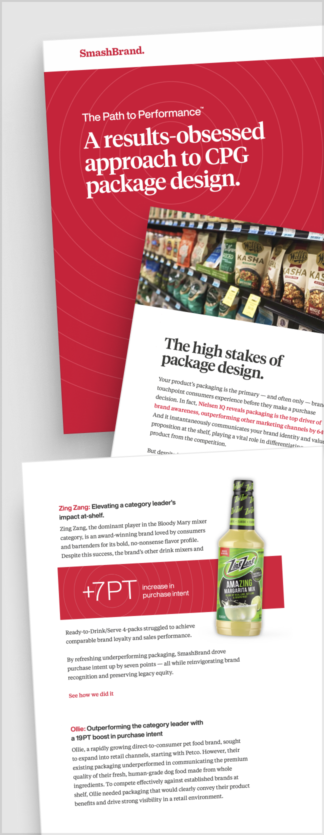
Path to Performance™
Taking a results-obsessed approach to CPG package design.
Discover how SmashBrand’s proprietary process, rooted in scientific principles, informed by data, and validated by your target audience, eliminates the guesswork from package design and delivers guaranteed results.
FMCG Packaging Design That is Guaranteed To Perform.
You now understand the importance of packaging design in an FMCG brand’s success. We encourage brand owners and managers to invest in creating research-driven packaging designs that are guaranteed to perform on-shelf.
That’s where SmashBrand comes in. We are the only agency to guarantee a performance increase with our pack design. That’s because our proprietary process combines research, strategy, design, & testing with iterations throughout. The result is a finished product that fosters consumer engagement, ultimately leading to increased purchase intent.
Book a time to discuss your project with our team.
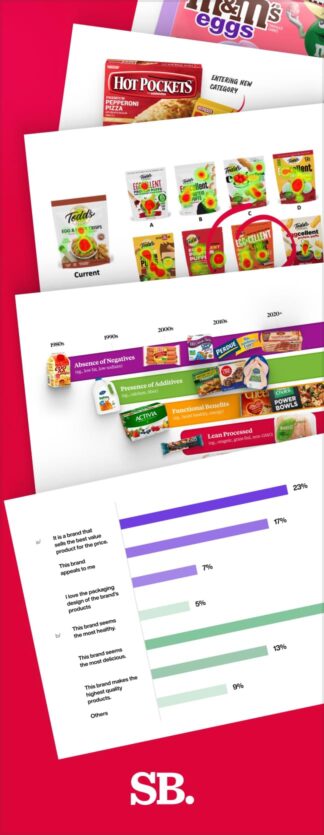
Nice Package
Don’t miss out on our monthly newsletter Nice Package!
Each month, we deliver a data-driven newsletter directly to your inbox, unpacking a critical topic in the FMCG & CPG industry.
"*" indicates required fields
Subscribe to
Nice Package.
A monthly newsletter that unpacks a critical topic in the FMCG & CPG industry.
Free Resource.
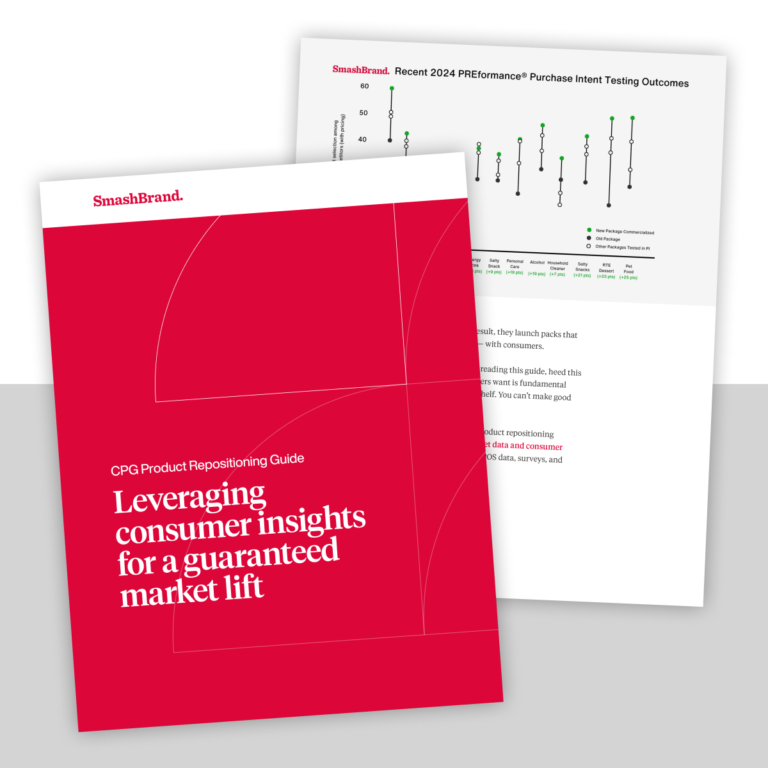
CPG product repositioning guide.
Explore the five undeniable signs your CPG product needs repositioning along with strategies for leveraging consumer insights for a guaranteed market lift.
Learn More About CPG product repositioning guide.
